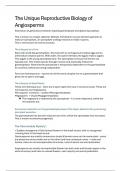Lecture notes
Trinity Term: Diversity of Life lecture notes
- Module
- Biology
- Institution
- University Of Oxford
Includes the following lectures: 1. The Unique Reproductive Biology of Angiosperms 2. Angiosperm Mating Systems & Pollination 3. Diversity of Life: Birds I 4. Birds II: Adaptation & Ecology: 5. Pollination mechanisms: 6. Plant-plant interactions: 7. Mammals: 8. Plant-Animal Interactions: 9...
[Show more]



